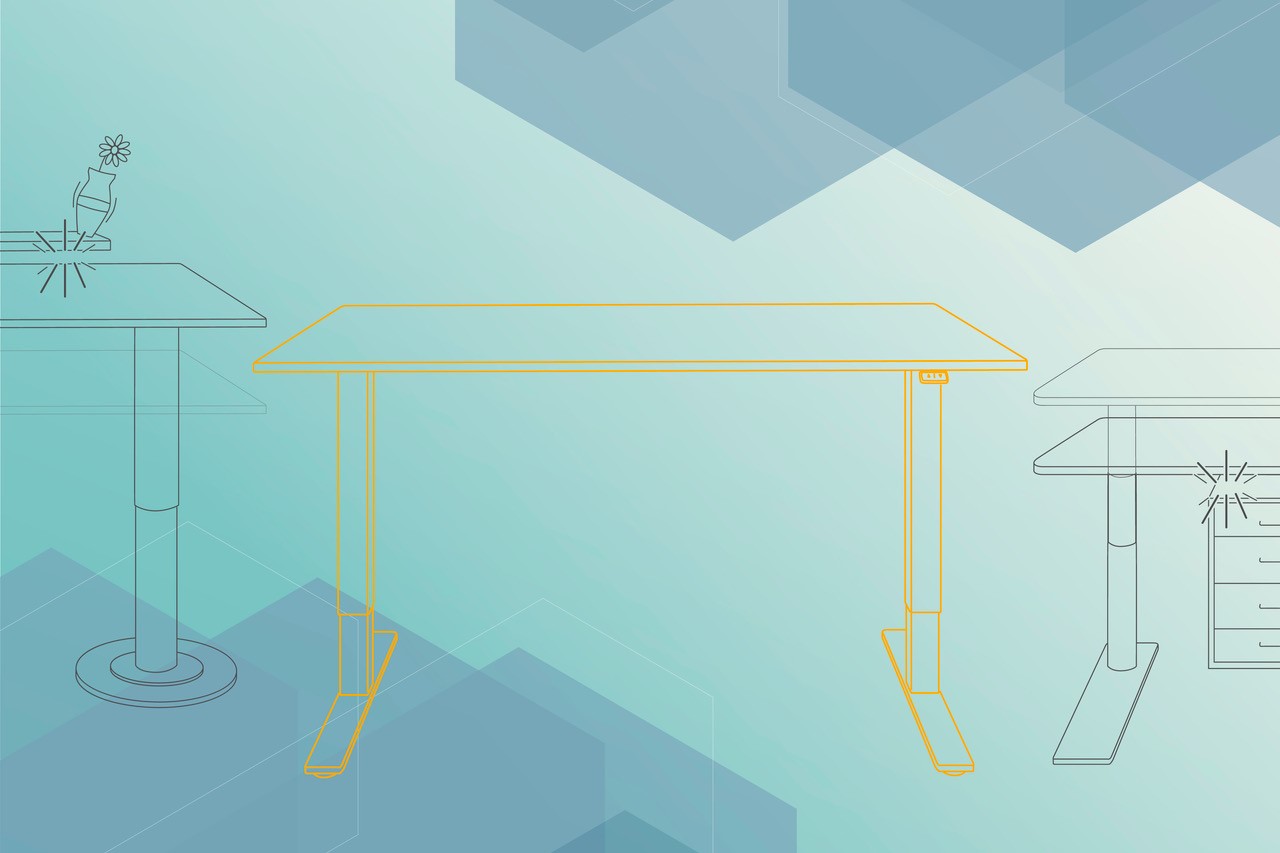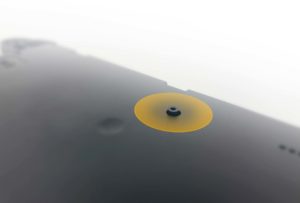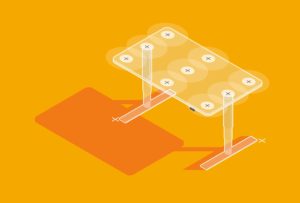Light Barrier vs. Gyroscope: Which System Protection is Best?
October 1st, 2020

With at least some sort of collision detection system supplied with almost every adjustable table on the market today, the question on the lips of the office furniture industry is a simple one: which system protection concept is best?
In the past, this was an easy question to answer. Strain gauge sensors like our own LOG-PRT-DMS dominated the landscape. This type of sensor remains a reliable aid in many types of modern adjustable, including the DYNAMIC MOTION system. However, recent technological advances have led to the emergence of two different collision detection solutions: light barrier solutions and gyroscope sensors.
Recently, we carried out a number of tests on our own light barrier concept, featured in the SMARTneo Control Box, against five separate gyroscope-based industry competitors to show you exactly how effective it can be. Our main conclusions were as follows:
- The light barrier system was almost 100% effective in recognizing collisions under all load states.
- Under “no-load” conditions, differences in the effectiveness of the two systems were minimal.
- However, under “full-load” conditions, some gyroscope systems were unable to register certain collisions, especially during downward movement.
- Load state generally had a far more noticeable impact on the effectiveness of gyroscope than the light barrier system. However, both systems were affected, especially during downward movement.
Let’s look at the two technologies and the results of the test in a little more detail.
Gyroscope vs. Light Barrier Solutions
Gyroscope
Gyroscopes can be small, plug-in devices that sit alongside a control box beneath the table top, or they can be integrated into the control box itself. In both variants, their job is to recognize unexpected movement: changes to the table’s normal motion caused by a collision or the presence of an obstacle. If the gyroscope registers a motion outside of a programmed range, the system stops before the damage caused by the collision becomes too severe.
The gyroscope is programed to recognize when the table top moves beyond a certain “tilt range”, which can be set in degrees. This creates two issues: firstly, because the outer edges of the table create a more significant tilt, sensitivity in the inner ranges will be lower. Secondly, because the force needed to tilt the table under heavy loads is higher, a greater force is therefore required to trigger the gyroscope. In other words, the more weight the table is carrying, the bigger the collision needs to be to cause the system to stop.
Light Barrier
Light Barrier systems, such as the one found in the SMARTneo, are built into the control box itself. The system functions by registering changes to the table top caused by collisions. When a collision occurs, the table top deforms slightly. This pushes a small plastic element downwards into a light barrier. When the light barrier is broken, the system stops, and reverse movement is triggered away from the hazard.
For consumers, the main benefits of the system are price and reliable collision detection functionality across the load spectrum. As it is pre-integrated into the system, end users gain effective protection for minimal extra outlay. Although certain aspects “in the field” may see variations in effectiveness: table top material, installation position, etc. our research shows that light barrier systems are even more effective than their gyroscope-centered competitors.
The Test
At LOGICDATA, we are convinced that our light barrier system provides the best pound-for-pound protection for control box-based adjustable systems on the market today: an important step in the development of system protection concepts that are affordable to everyone. It is for this reason that we decided to analyze the two emerging systems scientifically.
The tests on our own light barrier system against a collection of popular gyroscope-based collision detection systems aimed to clarify the following points:
- How does each system register collisions at 9 specified points on the table top?
- How does table load (no load, half load, full load) influence effectiveness?
- Does the direction of movement (upward/downward) cause variations in sensitivity?
The test was conducted over the course of several days and yielded hundreds of test results. The key point of measurement was how much force on the table was required to cause the system to stop. While a more detailed breakdown of the results is available from our sales team on request, we’ve explained some of the key points here with the help of Product Manager Christopher Mallaschitz:
Effectiveness of the Light Barrier under pressure at different points on the table top.
In theory, all types of collision sensor should provide more accurate readings when pressure is applied to the outer edges of a table, as movement at the extremities is greater and thus easier to register. However, our hypotheses was that because the light barrier is generally mounted towards the center of the table, its sensitivity in this range should be better than the gyroscope as well.
Our tests showed that, compared to the light barrier system, the gyroscope-based competitor products performed less effectively not just in the center of the table, but all across the board. In 74 of 78 test cases – collisions at different points on the table top under varying loads – the light barrier system could recognize a collision with less required force than the gyroscope. In only four cases did the consolidated average of the gyroscope sensor systems record a better result. Mallaschitz admits that these results are even better than planned:
“When we first started developing the light barrier concept, we were convinced that it would be more effective than a comparable gyroscope system, especially during collisions closer to the center of the table. However, we expected our advantage to be more subtle than it actually was. It surprised us how much more effective our system proved to be.”
Effectiveness of the Light Barrier under different load states.
Load – caused by objects on the table and the weight of the table top itself – affects system sensitivity for many reasons: the extra pressure on the motors, the physical effect of load on the table top’s material, the likelihood that the load will not be evenly distributed, and the time required to stop a heavier load moving at the same speed. Despite these technical challenges, the light barrier system was almost 100% effective in recognizing collisions under all load states. Mallaschitz explains:
“Load state had a less-noticeable impact on the effectiveness of the light barrier system than expected. We sell products with the promise that they will function under a wide variety of load conditions, so the system protection has to keep pace with that too.”
Comparing Light Barrier and Gyroscope System under different load states.
Our tests showed that under “no-load” conditions, differences in the effectiveness of the two systems were minimal, although generally favored the light barrier. However, under “full-load” conditions, the differences were far more extreme. The gyroscope systems were unable to register a number of collisions, especially during downward movement. Mallaschitz says:
“Although recognizing collisions with a fully-loaded table is far more complicated than in a no-load scenario, we found that the decrease in light barrier sensitivity in such conditions was far less problematic than the performance drop in the gyroscope models. This is important for consumers: a more sensitive system could be the difference between a catastrophic collision with serious damages and no damages at all.”
Conclusion
To conclude, the tests show that in real-world situations, the light barrier system can be far more effective in recognizing system changes and, as such, mitigating system damage. While both gyroscope and light barrier systems have their advantages, the latter remains the more sophisticated technological solution for the demands of the modern workplace.
What does this mean for the market? As the results of our tests show, top-quality protection needn’t cost the earth, as Christopher Mallaschitz explains:
In the current market, creativity and ingenuity are key to creating successful adjustable solutions: finding something that works reliably and making it as accessible as possible in terms of price. With the light barrier collision detection concept in the SMARTneo, we have achieved a remarkable blend of effective protection at an ultra-value price point, which, blended with the extensive feature set of the control box itself, makes our product the logical choice for the modern adjustable system.”
You can find out more about the advantages of the SMARTneo here www.logicdata.net/product/smartneo.
Need expert help optimizing your table system? Check out the optimization package as part of our all new LOGICservice portfolio www.logicdata.net/logicservice.





